Public Works and Environmental Services Alert:

If you find spotted lanternfly, please report your findings through the mobile app iNaturalist.
The spotted lanternfly (Lycorma delicatula) or SLF is an insect that is native to China, India, and Vietnam. In its native land where it cohabits with its predators, parasites, and pathogens it is not a problem insect. However, as with many other insects arriving to the United States from other parts of the world and finding no established natural enemies here, it has become very invasive.
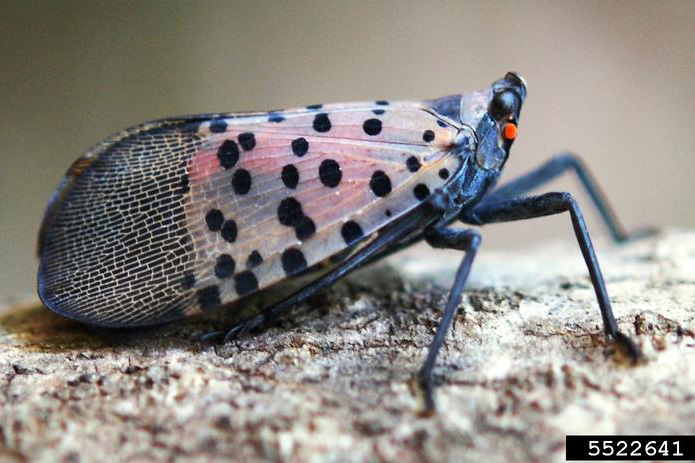
Adult Spotted Lanternfly. Photo credit: Lawrence Barringer, PA Dept of Agriculture, bugwood.org
The nymph and adult stages of SLF have piercing-sucking mouth parts that suck sap from the stems and twigs of more than 70 types of plants including hardwood trees, landscape vegetation, and crops such as apples, grapes, and hops. In large numbers they can damage and weaken plants, spoil crops, and make a big mess. In agricultural settings, SLF has been particularly damaging to vineyards. In urban areas, it has damaged landscape plants and become a real nuisance. The feeding causes oozing sap, wilting, leaf curling, and dieback. Like aphids, the SLF secretes undigested plant sugars that pass through it, called honeydew. This drops onto anything beneath drawing flies, bees, wasps, and ants that feed on it. Black sooty mold grows on the honeydew.
SLF has spread rapidly in the northeastern United States. It is a planthopper whose nymph and adult stages are excellent jumpers. Adults also use their two pairs of colorful wings when they jump, sometimes gliding long distances on a good wind. Another way it spreads is by “hitchhiking” a ride on vehicles, outdoor furniture, tools, firewood, nursery stock, and any other objects moved by human activity. The female spotted lanternfly lays her inconspicuous egg masses on objects that if undetected, can then be transported anywhere. Nymphs and adults will land on humans and objects and be moved to new locations as well.
First detected in 2014 in Pennsylvania, SLF has since spread to Connecticut, Delaware, Georgia, Illinois, Indiana, Kentucky, Maryland, Massachusetts, Michigan, North Carolina Ohio, New York, New Jersey, Tennessee, Virginia, and West Virginia. In 2022, SLF was found in western Fairfax County and is now found throughout the county.
Know How to Identify SLF
The adult spotted lanternfly is approximately 1 inch long with grey forewings with black dots. The hind wings have distinctive red patches with black spots and a white band. Immature stages are smaller and lack wings. They start out black with white spots and develop red patches as they mature.
If you are not sure that what you are seeing is spotted lanternfly, here are some resources that can help. The Virginia Cooperative Extension created this helpful guide to SLF look-a-likes, Possible Spotted Lanternfly Adult Look-alikes in Virginia. There are also some widely used mobile phone apps that allow users to submit photos of insects for identification, such as iNaturalist.
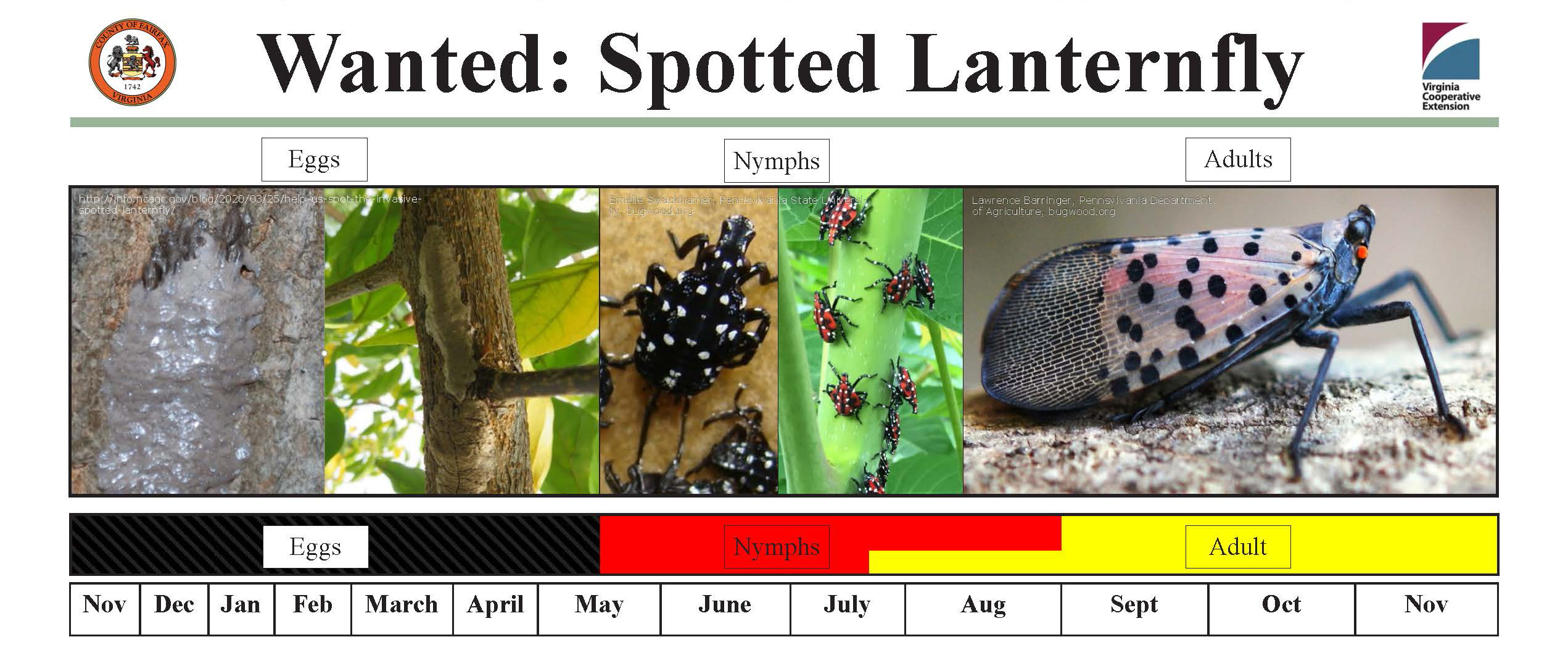
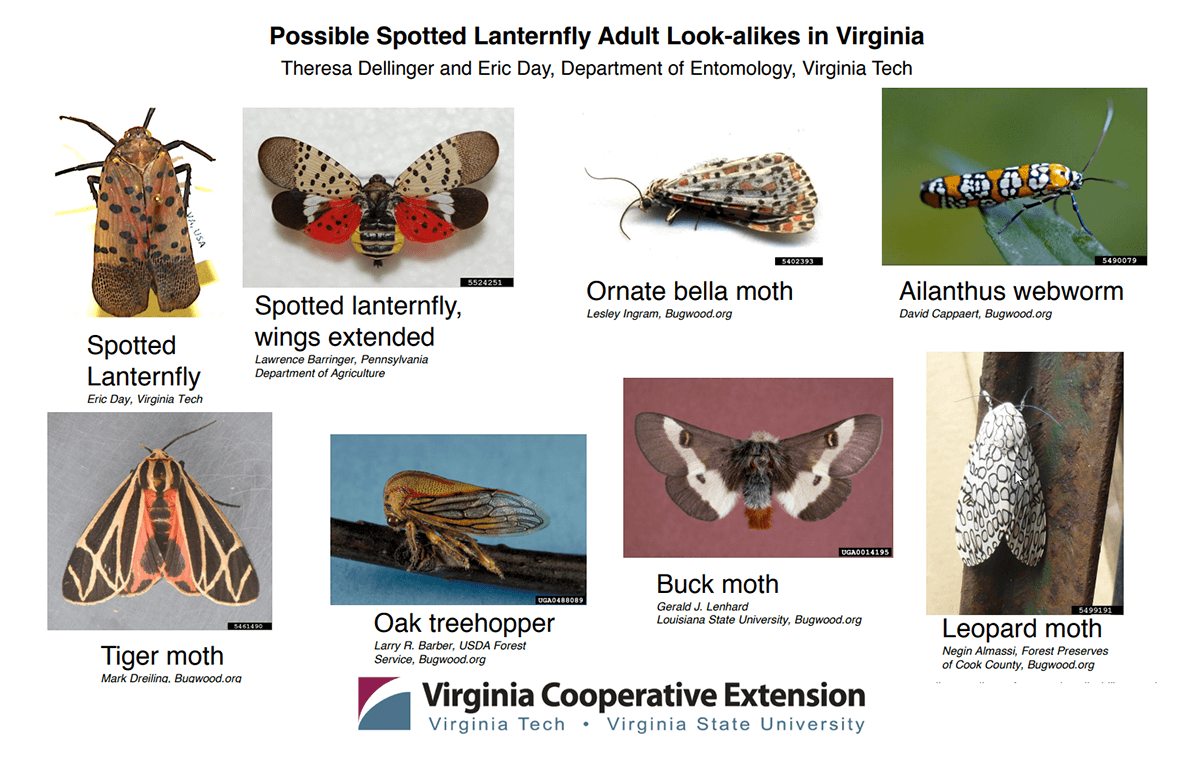
How to Report
If you find spotted lanternfly, please report your findings through the mobile app iNaturalist.
Spotted lanternflies can become a real nuisance on residential landscapes. They have not been the primary cause of death to ornamental and shade trees, but in high numbers they can be a contributing stress factor by reducing a tree’s abilities to synthesize and store energy. Heavy SLF infestations are very visible and may seem like the primary reason for a tree’s poor health but other environmental factors, especially too little or too much water, have a much greater impact on tree health.
SLF nymphs and adults are highly mobile, moving freely between plants and properties as they move through their life stages. They are therefore a moving target and there is no preemptive pesticide to keep them from coming on your property. Also, SLF may be present in high numbers on one plant or tree and not on others. They may be in low numbers one year and high numbers another.
If you find SLF on your property, take a deep breath and don’t panic . First, identify the life stages present using the identification guide above. Then remember, the goal is to manage the area safely, not to eradicate SLF because this is impossible.
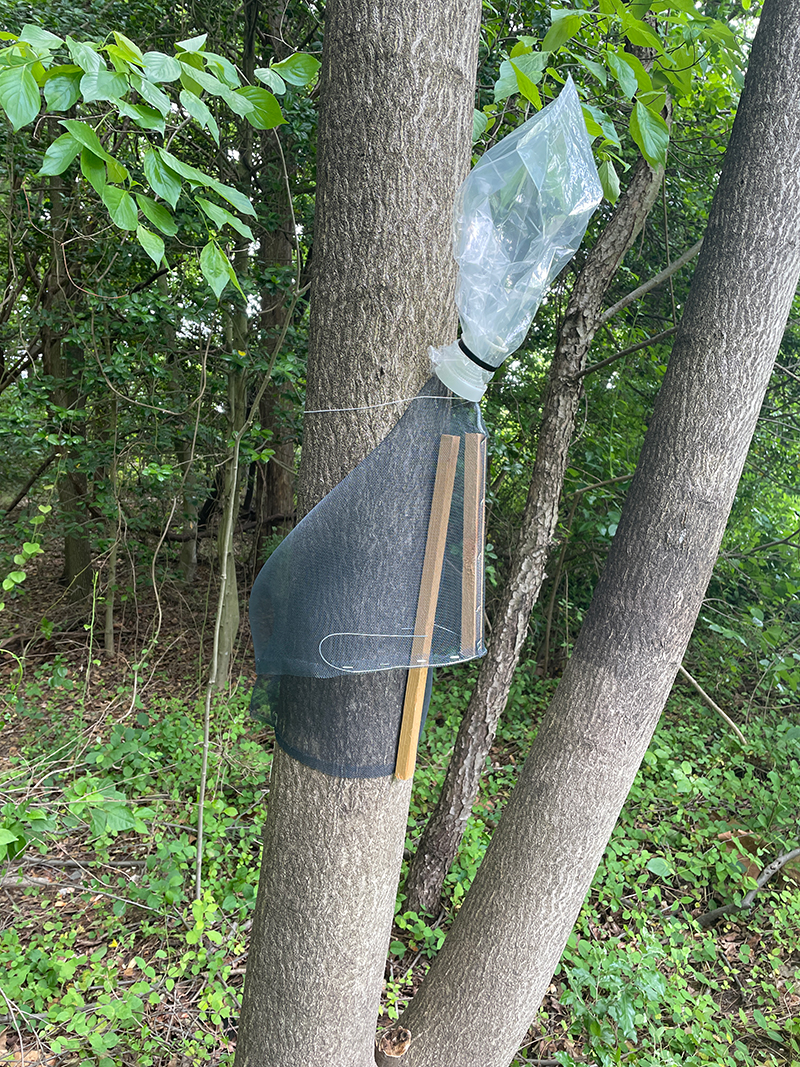 You can safely manage SLF on your property by doing the following:
You can safely manage SLF on your property by doing the following:
There are horticultural oils and pesticides approved for use to control SLF. They can be effective at killing spotted lanternfly when applied according to their labels. If it is necessary to use one, it should be used with great caution to protect yourself, other people, pets, birds, insects, and a host of pollinators that share some of the same plants as spotted lanternfly.
You can ask yourself these questions to determine if the use of an oil or pesticide is necessary,
Not every tree needs to be treated. You will need to assess each tree in its current state. The following should be considered before deciding to apply pesticide to an infested tree,
We recommend consulting the following resources for more information about SLF management on your property. They contain more detailed information about SLF management strategies and guidance on the type of pesticide that could suit your SLF management goals.
Spotted Lanternfly in Virginia | Virginia Cooperative Extension | Virginia Tech (vt.edu)
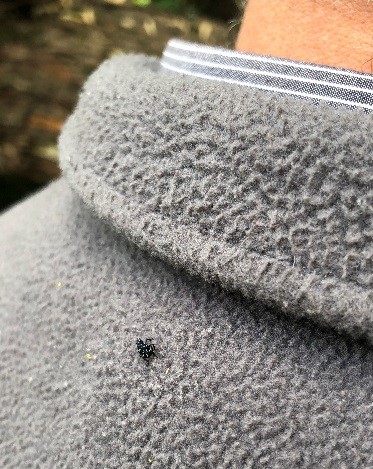
As of March 27, 2025, Virginia's spotted lanternfly quarantine has been repealed. This means that businesses moving regulated articles within Virginia are no longer required to hold a permit. However, some states still maintain spotted lanternfly quarantines and may require businesses shipping from Virginia to have a valid spotted lanternfly permit.
Details can be found here: Spotted Lanternfly (Lycorma delicatula)
Good practices to slow the spread are:
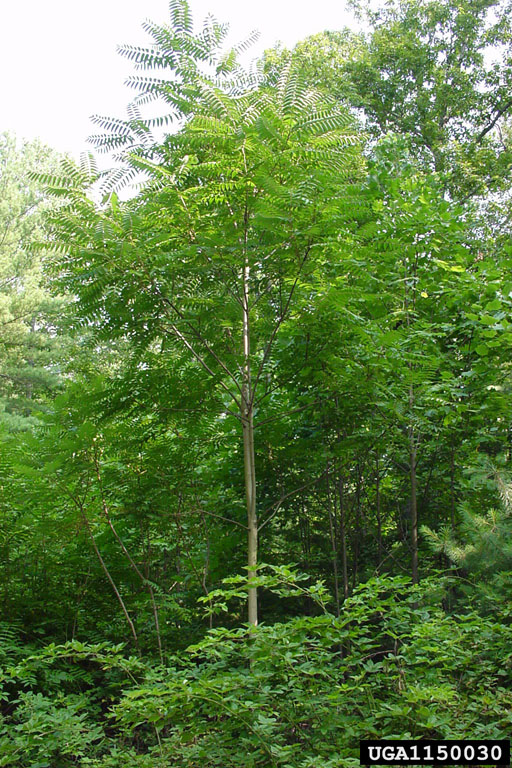
The spotted lanternfly’s most preferred host is its native host tree from East Asia, the tree-of-heaven (Ailanthus altissima). Here in Fairfax County, tree-of-heaven is an unwelcome invasive tree that does not support our native insects and competes with our native vegetation. SLF typically finds tree-of-heaven first then spreads to other plant species. Removal of tree-of-heaven from County-owned property is already underway to eliminate a nuisance tree and to slow the spread of SLF.
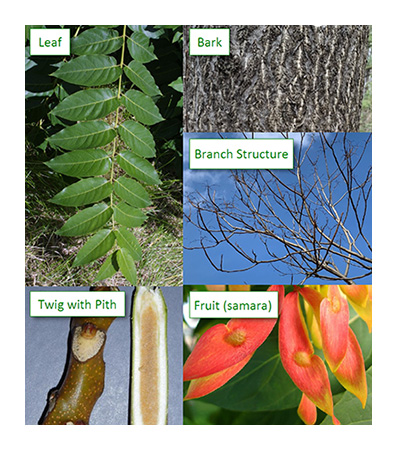 Tree-of-heaven has several unique features that distinguish it from similar looking native trees, such as the shape and underside of its leaves, its odor, and its seeds. Please see this visual guide to tree-of-heaven identification, Tree Identification – Virginia Tech, or this video explanation from Penn State, [Tree-of-heaven: Accurate Identification]. As with insect identification, plant identification can be challenging for beginners. Mobile phone apps such as iNaturalist are free to use and can be helpful.
Tree-of-heaven has several unique features that distinguish it from similar looking native trees, such as the shape and underside of its leaves, its odor, and its seeds. Please see this visual guide to tree-of-heaven identification, Tree Identification – Virginia Tech, or this video explanation from Penn State, [Tree-of-heaven: Accurate Identification]. As with insect identification, plant identification can be challenging for beginners. Mobile phone apps such as iNaturalist are free to use and can be helpful.
Remove tree-of-heaven from your property to reduce the impact of SLF. This may not prevent SLF from infesting your property, but it does take away a preferred food source. This is especially important near patios, decks, playgrounds, vehicles, and high value plants where honeydew can buildup on surfaces under the tree. Honeydew is harmless to people, but its sweetness attracts ants, flies, bees, and wasps. If the sticky buildup is not removed, it may begin to develop a sooty mold which can block sunlight from plants and stain surfaces. These are a major nuisance to homeowners and can diminish the enjoyment of being outdoors
Cutting the stem and leaving its roots does not permanently eliminate tree-of-heaven. A cut stump will be stimulated to grow new sprouts near it. Each of those would then need to be cut until the roots eventually die. Eliminating tree-of-heaven completely requires physically removing the entire plant including its roots. Pulling or digging out the roots is only practical with young saplings. Larger trees and stump resprouts require the use of herbicides for complete control. Please see the Virginia Department of Forestry Control and Utilization of Tree-of-heaven publication for more information.
Urban and Community Forestry Division is looking for tree-of-heaven on County property. If you find tree-of-heaven on County property, please report your observation using the EDDMapS mobile app or EDDMapS website.
View the Tree of Heaven Reporting Handout.
Take a picture and report it! Report your findings on the mobile app iNaturalist.
SLF will not harm most trees and yard plants. However, expect SLF to become a general nuisance because of the honeydew it excretes, which may encourage the growth of sooty mold and attract stinging insects. Additionally, they do not sting, bite, or cause harm to pets. Although if dogs and cats eat enough of them, they may vomit.
Tree-of-heaven cannot be simply cut down or mowed over as it will resprout heavily and spread. Effective management of tree-of-heaven requires removal of its root system or use of herbicide. Please refer to the Virginia Department of Forestry publication Control and Utilization of Tree-of-heaven for more information.
Please report tree-of-heaven through the EDDMapS mobile app or EDDMapS website.
Forest Pest staff are monitoring SLF Countywide in conjunction with the USDA APHIS Cooperative Agricultural Pest Survey (CAPS) and Virginia Department of Agriculture and Consumer Services (VDACS). High transit corridors such as rail lines, major highways, and rest stops are being checked. Finding it early will provide the best chance to control it.
For more information about tree pests and tree care, call the urban forester of the day at 703-324-1770 | TTY 711 or contact the Forest Health Branch by email.
